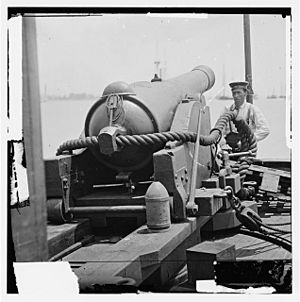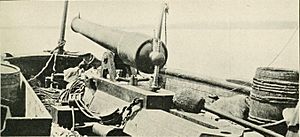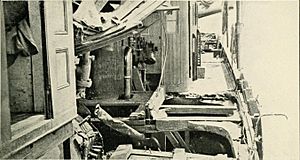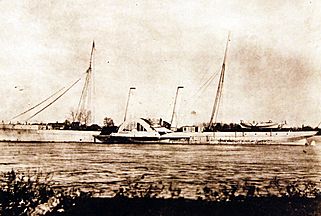CSS Teaser facts for kids
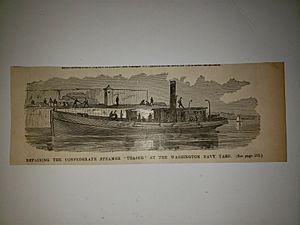
The Teaser on repairs after capture.
|
|
Quick facts for kids History |
|
|---|---|
| Name | Teaser |
| Operator | Confederate States Navy |
| Commissioned | 1861 |
| Fate | Captured 4 July 1862 |
| Name | Teaser |
| Operator | Union Navy |
| Acquired | 4 July 1862 |
| Commissioned | 1862 |
| Decommissioned | 2 June 1865 |
| Fate | Sold into merchant service at auction 25 June 1865 |
| General characteristics | |
| Displacement | 64 tons |
| Length | 80 ft (24 m) |
| Beam | 18 ft (5.5 m) |
| Propulsion | Steam engine |
| Complement | 25 officers and men |
| Armament |
|
The CSS Teaser was once an old tugboat named York River. It was used in Georgetown, D.C. before the American Civil War began. During the war, the Confederate States Navy took it over. It then became part of the famous Battle of Hampton Roads. Later, the United States Navy captured the ship. It was then renamed the first USS Teaser.
Contents
The Teaser was built in Philadelphia, Pennsylvania. In 1861, the State of Virginia bought it in Richmond, Virginia. It joined the naval forces in the James River. Lieutenant James Henry Rochelle of the Virginia State Navy was its first commander.
When Virginia joined the Confederacy, the Teaser became part of the Confederate States Navy. It kept working in Virginia's waters. On March 8–9, 1862, under Lieutenant William A. Webb, it helped in the Battle of Hampton Roads. It acted as a support ship for the CSS Virginia. The Confederate Congress thanked the Teaser for its actions in this battle.
The Teaser was special because it was one of the first ships to carry an observation gas filled balloon. This made it a pioneer "aircraft carrier." It also became a pioneer minelayer. On June 17, 1862, it was ordered to help General Robert E. Lee's Army of Northern Virginia. Under Lieutenant Hunter Davidson, the Teaser helped place "torpedoes" (which were actually mines) in the James River.
On July 4, 1862, the Teaser was fighting the USS Maratanza at Haxall's on the James River. A Union shell hit the Teaser's boiler, causing it to explode. The crew had to leave the ship. When the Maratanza captured the Teaser, it found a balloon on board. This balloon was meant for aerial reconnaissance (spying from the air) on Union positions.
The officers who commanded the CSS Teaser were:
- Lieutenant James H. Rochelle (May–June 1861)
- Lieutenant Robert Randolph Carter (June–July 1861)
- Acting Master William H. Face (June 1861-January 1862)
- Lieutenant William A. Webb (February 1862-)
- Lieutenant Hunter Davidson (June–July 1862)
Later that summer, the United States Navy took the Teaser into its fleet. It was assigned to the Potomac Flotilla. The USS Teaser mostly patrolled the Potomac River. It sailed from Alexandria, Virginia, south to Point Lookout, Maryland. Its job was to stop illegal trade (called contraband) between Maryland and Virginia. This helped enforce the blockade.
On September 22, it captured a schooner named Southerner in the Coan River. On October 19, near Piney Point, Maryland, it caught two smugglers and their boat. They were trying to cross the river to Virginia. On November 2, near the Rappahannock River, the tugboat found three men trying to break the blockade in a canoe. The Teaser arrested them and gave their illegal goods to Virginians who supported the Union. Four days later, in Chesapeake Bay, the Teaser captured the empty sloop Grapeshot and its three crew members.
By December 1862, the Teaser moved to the Rappahannock River. It joined other ships to help General Ambrose Burnside's attack on Richmond. On December 10, it exchanged fire with a Confederate cannon battery. This battery was on the south side of the river, about three miles below Port Royal, Virginia. After Burnside's difficult defeat at Fredericksburg, Virginia on December 13, the Teaser went back to its anti-smuggling patrols on the Potomac.
In March 1863, the Teaser and USS Primrose had a busy month. On March 24, they sent a boat team to explore Pope's Creek, Virginia. The team found two boats used for smuggling. They also gathered information from Union supporters in the area. A week later, on the night of March 30–31, they sent three boats to Monroe's Creek, Virginia. The day before, Union cavalry had surprised a smuggler there. The troops captured his goods, but the smuggler escaped. The boats from Teaser and Primrose succeeded where the cavalry had not. They also learned about other smugglers.
In April 1863, the Teaser left the Potomac. It joined Acting Rear Admiral Samuel Phillips Lee's North Atlantic Blockading Squadron at Hampton Roads. On April 17, it joined USS Alert and USS Coeur de Lion. They went on an expedition up the Nansemond River west of Norfolk, Virginia. However, the Teaser got stuck on the river bottom. It damaged its engine and had to leave the mission.
By mid-summer, the Teaser was back on the Potomac. On the night of July 27, it caught two smugglers with a boat full of tobacco. This happened at the mouth of Mattawoman Creek, south of Indian Head, Maryland. The Teaser destroyed their boat. It sent the prisoners and the tobacco to the Washington Navy Yard. On the night of October 7, the Teaser and another ship saw signals between Mathias Point, Virginia, and the Maryland shore. The two ships fired cannons into the woods at Mathias Point. They also told the United States Army's local police chief to be more watchful.
On January 5, 1864, the Teaser and USS Yankee sent a team of men ashore at Nomini, Virginia. They were investigating a rumor that Confederates had hidden a large lighter (a flat boat) and a skiff (a small boat) there. These boats could carry 80 men. The team, led by Teaser's commander, Acting Ensign Sheridan, found both boats. They destroyed the lighter and captured the skiff. During the landing, Confederate soldiers appeared on the hills above Nomini. But the Union gunboats fired some cannon shots, making them retreat.
In April, the Teaser, Yankee, USS Anacostia, USS Fuchsia, and USS Resolute went with an Army expedition to Machodoc Creek, Virginia. At 5:00 A.M. on April 13, the five ships left the St. Mary's River. They were with the Army's steamer USAT Long Branch. This steamer carried a battalion of soldiers led by General Edward Winslow Hincks. The Long Branch landed its troops around 8:00 A.M. The five ships provided cover for the landing. Some Confederate cavalry appeared on the south bank of the Machodoc. But they left when the Teaser and Anacostia sent four armed boat crews ashore. The landing party captured a prisoner, likely a smuggler, and a lot of tobacco. By April 14, General Hinks' troops were back on the Long Branch. They headed for Point Lookout. The Anacostia went with the Army steamer. The other four warships explored Currioman Bay and Nomini. They returned to St. Mary's, Virginia that afternoon to continue their patrols.
During the summer of 1864, the Teaser had to leave the Potomac again. This time, Union forces needed its cannons to help defend important bridges. These bridges were across rivers at the top of Chesapeake Bay, near Baltimore, Maryland. They needed protection from Lieutenant General Jubal A. Early's raiders. On July 10, the Teaser left the lower Potomac. It sailed around Point Lookout and headed up the Chesapeake Bay. That night, it had to stop in the Patuxent River because of strong winds and leaks in its hull. Before dawn the next morning, it continued up the bay. During the morning, the leaks got worse. By the time it reached Annapolis, Maryland, it had to remove its exhaust pipe for quick repairs. Early that evening, the Teaser arrived in Baltimore for more repairs.
The gunboat did not reach its destination, the bridge over the Gunpowder River, until late on July 12. It was too late; the bridge had already been burned. It immediately returned to Baltimore. It reported on the bridge and picked up weapons and supplies for other ships in the Gunpowder River. When it got back to the bridge, orders were waiting for it to return to the Potomac. The Teaser left the northern Chesapeake. It reported back to the Potomac Flotilla at St. Inigoes, Virginia on the St. Mary's River late on April 14.
For the rest of the war, the Teaser and its fellow ships patrolled the Potomac. They helped slowly cut off supplies to the South. This contributed to the South's defeat by April 1865. Less than two months after General Robert E. Lee surrendered, the Teaser was taken out of service. This happened at the Washington Navy Yard on June 2. It was sold at a public auction in Washington to Mr. J. Bigler on June 25. The tugboat was renamed York River on July 2, 1865. It was used for commercial purposes until 1878.
Images for kids


